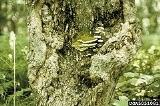
Eutypella parasitica
Encyclopedia
Eutypella canker is a plant disease caused by the fungal pathogen Eutypella parasitica. This disease is capable of infecting many species of maple trees and produces a large, distinguishable canker on the main trunk of the tree. Infection and spread of the disease is accomplished with the ejection of ascospores from perithecia. Therefore, the best ways to manage the Eutypella canker is to remove trees that have been infected by Eutypella parasitica. If infected, it can decrease the quality of wood cut for lumber thus it can have a negative impact economically.
Symptoms are similar to all species of maple and include a canker forming most commonly between 2-12 feet from the ground (3,7). The formation of the canker begins with a small pronounced necrosis of the bark and requires several years to expand. It enlarges as the tree ages by increasing its width and forming ringed callus around it (7). The extent of it practically surrounds half the trunk with a typical size ranging from .3 to 2.5 meters in diameter. Although the canker can become quite large, it normally does not kill the tree but does increase the risk of the trunk failing and being blown over by the wind. If the bark is peeled back at the center of the canker, a mat of white mycelia fungal tissue will be visible (1).
Hosts and symptoms
Eutypella canker infects many species of maple trees, most prevalently the sugar maple(Acer saccharum). Others commonly affected are the red maple(Acer rubrum), box elder(Acer negundo), striped maple(Acer pensylvanicum), Norway maple(Acer platanoides), sycamore maple(Acer pseudo-platanus), silver maple(Acer saccharinum), and black maple(Acer nigrum) (5,6). Onset usually occurs with greater probability of younger maples since they are more susceptible (3).Symptoms are similar to all species of maple and include a canker forming most commonly between 2-12 feet from the ground (3,7). The formation of the canker begins with a small pronounced necrosis of the bark and requires several years to expand. It enlarges as the tree ages by increasing its width and forming ringed callus around it (7). The extent of it practically surrounds half the trunk with a typical size ranging from .3 to 2.5 meters in diameter. Although the canker can become quite large, it normally does not kill the tree but does increase the risk of the trunk failing and being blown over by the wind. If the bark is peeled back at the center of the canker, a mat of white mycelia fungal tissue will be visible (1).

